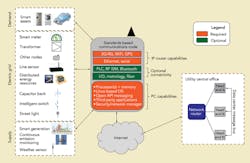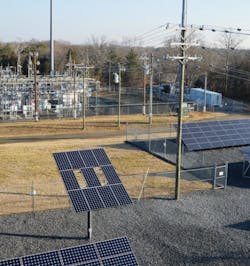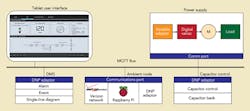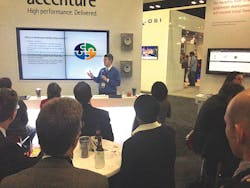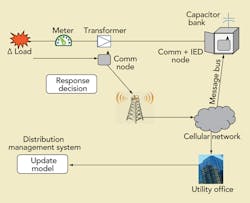Duke Energy's Platform for Interoperability and Distributed Intelligence
By Raiford L. Smith, Duke Energy, and Wade P. Malcolm, Accenture
When it comes to avenues of commerce, nothing beats the nation’s electric power grid. In the United States alone, the wires that cross the country are responsible for more than US$350 billion in sales each year.
The future of the grid has been defined, in part, by investments in a myriad of smart devices to add digital processing, data analysis and communications capabilities to an aging analog infrastructure. But, these devices do not necessarily enable all the capabilities of the smart grid. Instead, the ability to unlock this future lies in how well devices can integrate. If utilities can get assets to work together seamlessly, then utilities and their customers will realize real financial and operational benefits.
Unfortunately, the systems and supporting devices that comprise today’s grid are not set up for this. Most new devices consist of proprietary hardware, telecommunications and software. While these proprietary devices appear financially attractive when purchased, they often become surprisingly expensive over time because of inevitable integration issues limiting the lifetime benefits from the investment. And that outcome is not good for Duke Energy or its customers.
Strategy and Insight
In 2007, Duke Energy developed a holistic strategy to leverage a standards-based infrastructure to provide connectivity, interoperability and distributed intelligence. Enabled by various communications protocols, this platform also could reduce costs (relative to single-purpose, siloed solutions), improve operational performance, manage data and improve the security of the grid. This strategy led to Duke Energy’s implementation of a communications node-centric architecture, with more than 140,000 nodes in the utility’s Ohio and North Carolina service territories.
The nodes have been operating successfully for more than five years, allowing Duke Energy to gain valuable operating insights and develop new uses for the node-based architecture.
Accenture also has been involved in a variety of roles since 2009, helping to develop specifications for enhanced node designs, evaluation and testing of enhanced node products, assessment of wireless technologies deployed, and smart grid network architecture development in addition to the present efforts to assist in integration and applications development.
Duke Energy has continued to build on its nodal architecture, connecting communications nodes through wired (power-line carrier, serial and Ethernet) and wireless (3G and LTE [long-term evolution] cellular, WiFi, 900-MHz ISM) solutions to a growing list of transmission, distribution and customer-owned assets, including line sensors, gas meters, electric meters, regulators, capacitors, reclosers, switches, streetlights, battery storage, inverters, in-home load monitoring, electric-vehicle charging, weather sensors and smart appliances.
In 2013, Duke Energy began several projects to expand the interoperability and node connectivity necessary for distributed intelligence. Duke Energy and six forward-thinking companies launched the primary interoperability project using standards-based solutions to break down traditional grid device-centric silos. These companies are working together to prove that disparate data sets and control commands can be made to communicate effectively across multiple platforms without expensive integration efforts.
Interoperability and Distributed Intelligence
Duke Energy’s goal is to improve the lives of millions of people every day by providing affordable, reliable and clean electric and gas services in a sustainable way. Interoperability is a key component to achieving that goal because it can eliminate back-office systems and hidden integration costs, improving financial and operational performance. To accomplish this goal, the electric grid of the future needs to have close integration between all devices, not just the assets purchased from a single vendor. Thus, a standards-based interoperability solution is necessary in order to economically unlock data and systems from disparate vendors.
Interoperability is not the only capability needed for the future grid. As more customers install distributed energy resources (DERs), electric grids become more expensive and unstable. Thus, utilities need solutions that can rapidly respond to localized issues as DERs are deployed. Centrally managed systems — while effective at managing broad, slow-moving problems — cannot react economically with the speed and precision necessary to meet these new challenges. Yet, localized optimization cannot occur without strong interoperability between devices.
Duke Energy believes distributed intelligence and interoperability are key enabling (and interrelated) technologies. These solutions are necessary for widespread adoption of future DERs, may provide new revenue sources, and can integrate and optimize customer assets with utility system operations.
Industry Collaboration
Duke Energy’s collaboration with six hardware, software and services companies is making interoperability a reality for the utility industry. The companies are using a communications node architecture and an open-source field message bus to share data between disparate assets, enable peer-to-peer communications and federate data from previously siloed systems. The project collaborators are exposing some data locally through a standards-based interface. Conceptually, this allows utilities to choose the best components for the job, rather than buying prepackaged vendor-specific solutions that may be strong in some tasks but weak in other functions.
To achieve interoperability, the field message bus abstracts the applications and data from the underlying operational and telecommunications infrastructure. In other words, this solution allows applications to be developed independently without detailed knowledge of the corresponding hardware and networking assets. With true interoperability through a field message bus and distributed intelligence, the grid can provide a more efficient, coordinated approach to existing and new functions such as solar smoothing, field-based battery control and voltage management.
Yet, this solution does not preclude coordination with centralized systems. For example, changes in equipment status can be backhauled to higher-priority systems to update system models or to make more complex decisions.
Duke Energy appreciates the work of the companies pioneering this effort, which it hopes will provide future benefits to the entire industry:
- Accenture is providing strategy, integration services and applications development.
- Alstom Grid is providing coordination to its distribution management system.
- Ambient is providing a project platform and the enhanced communications node.
- Echelon is providing metering and the supporting infrastructure.
- S&C Electric is providing capacitor control technology.
- Verizon is providing cellular communications.
This collaboration could fundamentally change how Duke Energy procures, installs and integrates technologies. The strategic impact this work can have on the industry is similarly noteworthy as it helps to advance integration of new asset classes (for example, distributed generation, storage and nodes) into operations at scale.
Field Message Bus
Utilities’ pursuit of asset interoperability is not a new concept. The industry has made steady progress since the inception of the Utility Communications Architecture, but much more remains to be done. This new work has focused, in part, on the definition, testing and implementation of an open-source, broker-agnostic, peer-to-peer, distributed field message bus solution that is consistent with modern telecommunications architectures. Work to date has focused on the use of message queuing telemetry transport (MQTT) for voltage management and solar smoothing applications. Work on other protocols is currently underway.
Invented by Andy Stanford-Clark of IBM and Arlen Nipper of Cirrus Link Solutions, MQTT is an open-message protocol for machine-to-machine communications. MQTT was selected for the initial demonstration because it is already an open-source standard in other industries and allows for low power consumption, high performance and reliable delivery of real-time updates that can be acted on as they occur.
MQTT extends connectivity beyond traditional enterprise boundaries and into smart grid field components, and allows for massive scaling as more smart devices are installed. Open and free versions of MQTT are available, providing low-risk opportunities for adoption. It employs publish and subscribe messaging to facilitate the distribution of messages and allows service-level flexibility of message delivery with some built-in support for loss of contact between a client and a server. Furthermore, MQTT is compatible with multiple programming languages, reducing the cost and complexity of adoption.
Demonstrations and Field Trials
Duke Energy and the collaborating companies recently demonstrated lab and field trials of these technologies at the McAlpine, Rankin and Sherrill’s Ford substations in Charlotte, North Carolina, U.S. And at DistribuTECH 2014 in January, they demonstrated a voltage management application. Duke Energy and its project collaborators proved interoperability can be achieved through a field message bus and distributed applications.
The on-floor DistribuTECH demonstration, held in Accenture’s booth, provided an Android tablet user interface that displayed meter voltages, voltage set points, communication statistics and an electrical one-line for the mini feeder set up for the demonstration.
To start the demonstration, a user used the tablet to command a power supply to raise or lower voltage. Connected meters sensed the voltage change and sent an undervoltage or overvoltage flag through a power line carrier to a communications node. The communications node then published the voltage flag over the cellular network through the message bus to a separate communications node residing in Ambient Corp.’s booth.
Once the flag was published on the message bus, the voltage management application, written by Accenture, picked up the voltage flag and initiated an action to correct the issue. The voltage management application then sent a command wirelessly to the S&C Electric booth to close or open a simulated capacitor bank being controlled, based on the specific voltage measured.
Whenever the capacitor bank was opened or closed, the capacitor’s status change was published onto the message bus, updating the capacitor bank status on a distribution management system residing in Alstom Grid’s booth. Alstom then published an updated one-line back to the message bus, and that information was picked up by the tablet back in Accenture’s booth to show the closing of the capacitor bank. All wireless communication was over Verizon’s 3G and LTE networks.
This demonstrated the use of such techniques as distributed intelligence and a field message bus is achievable today. The technology is available. Other industries such as banking, transportation and high tech are already using it and reaping the benefits of this interoperability. Utilities can leverage some of the same technology and leading practices from other industries to better manage the grid.
Savings and Benefits
This system demonstrates a paradigm shift toward using distributed, intelligent devices that easily integrate with Duke Energy’s smart grid infrastructure to enable a higher penetration of intelligent, connected devices.
Using distributed intelligence applications in the electric grid has the potential to achieve additional cost savings, enhanced operational performance, improved system response times and better scaling of field devices. The field message bus enables data from devices to be shared locally without requiring costly integration, leading to more efficient decisions and lower latencies.
In addition, data storage, telecommunications and integration costs can be reduced because data can be federated from siloed systems, allowing information to be intelligently routed and stored where needed. This stands in sharp contrast to today’s centralized backhaul-everything-in-case-it-is-needed design philosophy.
Standards-based interoperability also can improve life-cycle costs through reductions in integration costs, reuse, reduced training and maintenance costs. Lastly, benefits can come from new, distributed intelligence applications that can provide improved operations and savings from new functions such as solar smoothing.
Next Steps
Duke Energy and its collaboration partners will continue to develop innovative interoperability solutions, highlighting the performance benefits and cost savings that can be achieved by connecting assets locally. For example, Duke Energy has implemented this same approach to support a solar smoothing application — which integrates battery storage, inverters and meters at three different locations — and development work on a microgrid application is just starting.
In addition, Duke Energy plans to integrate these same concepts into its procurement process, requiring new equipment and systems to demonstrate interoperability through implementation of an adapter to a standards-based message bus such as MQTT. Duke Energy and its collaboration partners are excited about the potential that interoperability holds, allowing everyone to better meet customer commitments and provide better integration capabilities for the industry as a whole.
Call to Action
This effort has proven multiple vendors can collaborate together over a standards-based, open-source field message bus with distributed applications to increase security, reduce latencies, compress data traffic and reduce costs.
The companies are planning a second phase of development and demonstration during 2014-2015. Interested parties are welcome to participate. A webinar is planned for later this year, and a website has been set up to provide access to open-source code for other utilities to launch their own project activities and to provide progress reports, architecture design documentation and information on how to participate and follow progress being made.
Raiford Smith is director of smart grid emerging technology for Duke Energy. His team evaluates and develops new and emerging transmission, distribution, information technology and telecommunications technologies for the smart grid.
Wade Malcolm is managing director in Accenture Smart Grid Services. He has more than 30 years of experience with utilities involving consulting, technology development and delivery, and operations.
Editor’s note: The authors look forward to talking with other utilities about how they can use this technology to make improvements in their grid operations. Please contact the authors to obtain more information on how to participate.
About the Author
Raiford Smith
Vice President, Energy Technology and Analytics
Raiford Smith and his team lead Entergy’s pursuit of new, enabling technologies such as Distributed Energy Resources, big data analytics, and the development of customer-facing products and services. Mr. Smith is based out of Entergy’s offices in The Woodlands, Texas. Entergy is an integrated energy company that owns and operates approximately 30GW of electric generating capacity and delivers electricity to 2.9 million utility customers in Arkansas, Louisiana, Mississippi and Texas.
Mr. Smith has 26 years of experience in the energy industry, including various roles in legal, planning and analytics, smart grid, customer management, demand-side management, pricing and rates, product development, wholesale deal structuring, mergers and acquisitions, and technology.
A native of Savannah, Georgia, Smith earned a Bachelor of Science degree in computer science from the University of Georgia, a Masters of Business Administration degree from the Darden Graduate School of Business Administration at the University of Virginia, and a Juris Doctor from the Charlotte School of Law.
Mr. Smith is a licensed attorney and member of the North Carolina Bar Association; holds several patents on grid optimization and electric grid technologies; has published several papers on the future of the smart grid, energy efficiency, asset optimization, and price forecasting; has earned his Six Sigma Green Belt certification; and is a member of advisory boards for SAS, Tendril, Intel, and NEST Labs.

